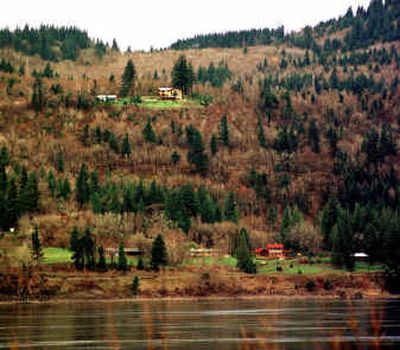Size becomes big issue in Gorge housing debate

CORBETT, Ore. – For years, the high-profile battles over home-building in the scenic Columbia River Gorge have centered on visibility – whether a home is marring the area’s dramatic waterfall and cliff-filled landscape.
But now, the debate has widened to include the sizes of the homes being built in the area.
This fall, for the first time, gorge regulators filed appeals to reduce the size of three planned homes.
Nobody knows for sure how many big homes have escaped the notice of commission planners, but many appear to have sprung up around Corbett in Multnomah County and Washougal in Clark County, Wash.
Once they’re built, they can pave the way for other super-sized homes in the neighborhood, thanks in part to a Columbia River Gorge Commission rule that says: “New buildings shall be generally consistent with the height and size of existing nearby development.”
Each of the six counties with land in the scenic area base their land-use ordinances on Gorge Commission regulations, but each county has its own formula to determine whether a house is consistent with its neighbors.
As a result, county calculations of home sizes sometimes differ by several thousand square feet from the commission’s numbers.
David Annus of Corbett planned one of the homes now facing a challenge from commission staff. The planned house was to be 5,700 square feet, with a three-car attached garage.
Annus told the Oregonian newspaper he had factored visibility concerns into his plans for the home, but was surprised when the home’s size came under question.
“I feel like the Gorge Commission has created kind of a whole new standard for me here,” said Annus, a mortgage broker.
But Martha Bennett, the Gorge Commission’s executive director, said the surrounding homes average just 2,900 square feet.
A Multnomah County hearings officer disagreed with Bennett, saying Annus’ plans were suitable for the area. She has now appealed the home to the full membership of the Gorge Commission, which will consider it this year. If anyone disagrees with the commission’s judgment, the next stop will be the state Court of Appeals.
Annus said the appeal has delayed the start of his home until at least the summer. “I’m just sitting and waiting,” he said.
The other two cases Bennett has appealed are a 4,400-square-foot home and a 5,800-square-foot home, both in Clark County. Hearings officers also rejected those appeals, and Bennett hasn’t decided whether to go further with them.
The 12-member volunteer Gorge Commission has approved more than 900 homes in the scenic area since its inception in 1986. About 700 of them have been built, ranging from less than 1,000 square feet to 14,000 square feet.
Limiting home sizes is an example of government controlling the rights of individuals, said state Sen. Ted Ferrioli, R-John Day.
“What are we saying here? We don’t want rich people living in the community?” Ferrioli said. “We’re against schools getting money? Property taxes?”
The senator was key in cutting the Gorge Commission budget from $1.6 million to $1.45 million in 1999-2001, and said the system in the scenic area already requires homeowners to go through the public process and meet a multitude of legal requirements.
“If it’s not against the law,” he said, “it’s compatible.”
But Gorge Commission member Walt Loerke said the bigger houses are “morally disgusting.”
They have wasted space and consume huge amounts of raw materials, said Loerke, a builder from Skamania County.